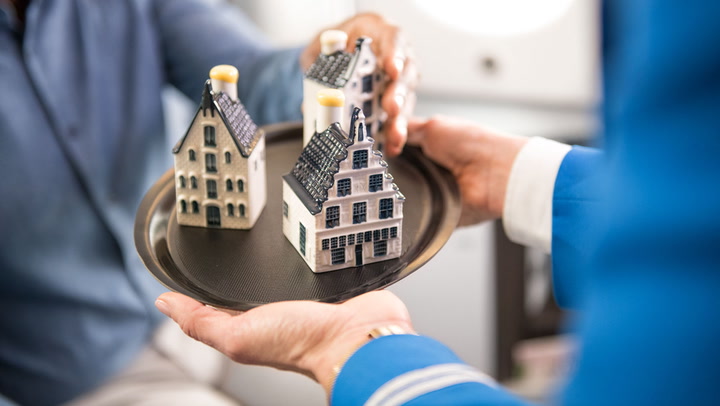Summary
- Introduction: An overview of KLM’s unique in-flight collectible.
- The Delft Blue House: Historical significance and design details.
- Collectibility: Insights on rarity and market value.
- Legacy: The cultural impact of KLM’s amenities.
Fly up front with KLM Royal Dutch Airlines, and you’re gifted something with lasting appeal. If you traditionally think of first class as merely a comfortable bed in the sky, it’s worth noting that a long-haul experience in a premium cabin can include various perks, ranging from gourmet meals to luxurious pajamas. However, among these features, the amenity kit—often comprising scented lotions and travel-sized gels—might not receive much attention. KLM, on the other hand, offers a collectible that has become iconic among frequent flyers: the Delft Blue House.

Identifiable by its blue-and-white glaze, Delftware is a style of pottery linked to the Dutch city of Delft since the mid-17th century. While touring the Netherlands, you may see it on dishware, tulip-lined vases, and more. Since 1952, KLM has transformed this traditional craft into a series of miniature houses, each one resembling a historic building from across the country.
The airline presents these collectible houses to customers on all business intercontinental flights. According to a KLM representative, “The houses have become a collector’s item across the globe.” The presentation of these houses adds a unique element to the flying experience, making it feel more like a ritual as passengers anticipate receiving their latest addition.

KLM’s production of these houses was somewhat random until 1994. Initially, several houses were produced in succession, followed by long periods without any new releases. An extra 15 houses were created in 1994 in celebration of KLM’s 75th anniversary, bringing the total to 75, a number that has continued to grow alongside the airline’s legacy.
Notably, on October 7, 2019, KLM celebrated its centennial by unveiling house number 100, a replica of Huis ten Bosch, the royal palace in The Hague. King Willem-Alexander’s input on the design adds a special touch, considering he is also a KLM pilot.
While KLM does not sell these unique souvenirs directly, they can be found on the secondary market, with older versions sometimes fetching prices exceeding $10,000 at auction. Each house traditionally comes filled with 35 milliliters of genever, a juniper-infused spirit that is a historic precursor to gin, native to Holland.
The tradition of filling the houses with Bols Genever began in the 1980s. Before this, they included various liquors from established Dutch distilleries. At one point, due to alcohol policies in certain Middle Eastern destinations, KLM even provided house-shaped ashtrays instead.

Interestingly, around 79,000 of the liquid-less houses are loaded onto KLM flights each year, compared to 800,000 that include genever. Each delicate ceramic house is sealed with a cork stopper and wax, marking it as a cherished collectible rather than just an in-flight amenity.
Back in 1952, airlines could not provide gifts to customers due to competition regulations. KLM ingeniously navigated this restriction by creating the Delft Blue Houses filled with genever, providing a unique service while sidestepping the law. This strategy has blossomed into a beloved tradition over the decades.
Today, KLM’s Delft Blue Houses represent more than just unique airline amenities; they embody a cultural touchstone that captures Dutch heritage. As KLM approaches its 103rd birthday, anticipation builds for what new creations will join this exceptional collection. In the meantime, aviation enthusiasts and collectors alike will continue to seek out these remarkable pieces that bridge the airline experience and Dutch culture.





